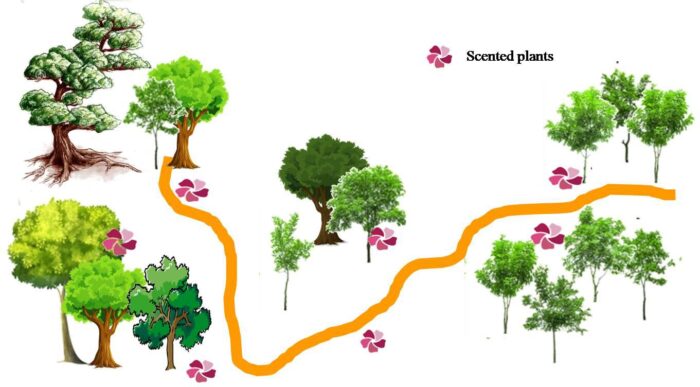Misty morning, rays of the sun, chirping of birds, lively greenery, and an isolated unaddressed path, so you are in a forest trail. Be it for the sake of stress release, adventure, exhilarating hiking, education or research a trail always infuse us with positive energy, rejuvenate our link with the nature and quench our thirst for unknown and enigmatic lives. A biodiversity-rich forest is a visual and auditory delight for trail lovers as it provides the opportunity to experience versatile plant and animal lives.  But, do you have any idea that even our olfactory senses have some role in our enjoyment, understanding, and learning biodiversity? Yes, it is the very smell, a powerful but under-recognized instinct which may add flavors to our biodiversity journey.
But, do you have any idea that even our olfactory senses have some role in our enjoyment, understanding, and learning biodiversity? Yes, it is the very smell, a powerful but under-recognized instinct which may add flavors to our biodiversity journey.
Smell either through scented flowers or other plant parts, pheromones from animals does multitasking in the natural world. It is a sensory medium to attract the opposite sex for mating, to defend against predators, to lure pollinators, and for seed dispersal to lay the foundation for the next generation. However, in our understanding of biodiversity and its perception to commoners, smell seems to have little role. It is the niche area for specialists or locally-learned individuals those who acquire the skill either through training or tradition. To promote the public engagement in biodiversity conservation, Sarawak Biodiversity Centre, Malayasia introduced the concept of scented trail inside the forests of Semenggoh.
The scented trail is unique as the trail explores naturally occurring fragrant plants as well as planted forest trees to provide you with the opportunity to sniff out and identify them through their scents. Currently, there are two trails covering the alluvial forest and the old low-land secondary forest (Ecology trail), and the low land rainforest (Discovery trail) of Sarawak. Both the paths are dotted with plants like Phalaenopsis bellina or Normah Orchid (vanilla and jasmine like scent), Coelogyne asperata (liquorice like scent), Bulbophyllum becari (rotten meat lie scent), Goniothalamus macrophyllus (aromatic bark), Cinnamomum javanicum (cinnamon scent and use in cooking) and many such examples. Apart from this olfactory delight, those who can sniff out all enlisted fragrant plants to be awarded “Wilderness Explorer” medal from the center. Let’s take the call, a scented walkway is waiting for you.
Source: https://www.sbc.org.my/sbc-news/publications/462-making-scents-of-borneo-s-biodiversity/file
Image : Rajasri Ray (developed from google images)
Collector: Rajasri Ray



